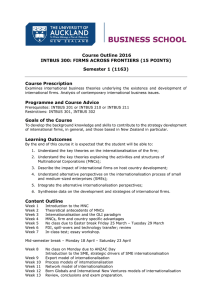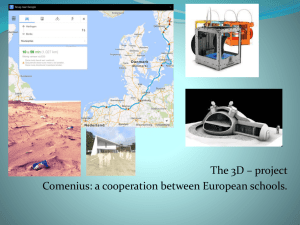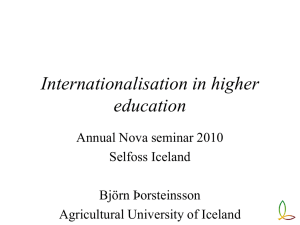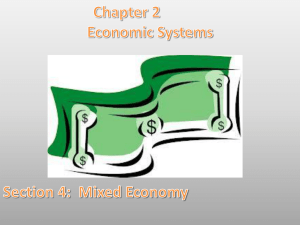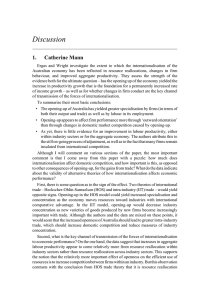ibtopic_4_-_ib_theories
advertisement
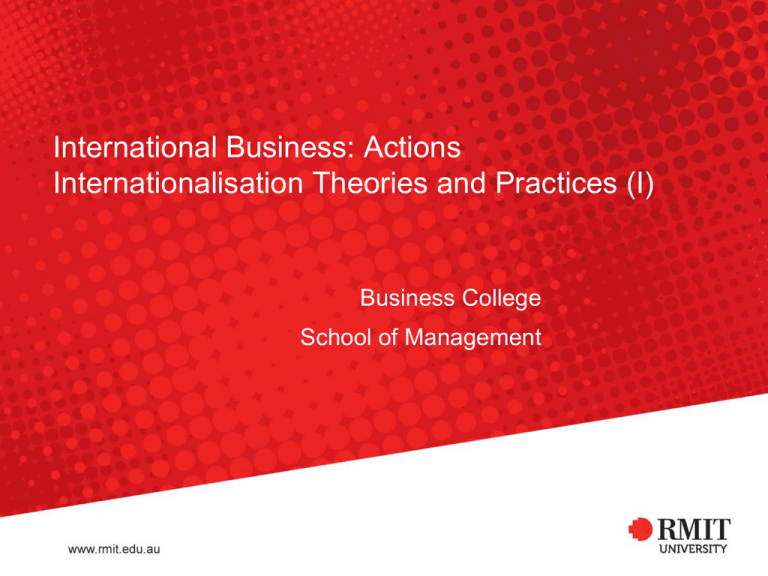
International Business: Actions Internationalisation Theories and Practices (I) Business College School of Management Key Learning Objective • This session will help you to understand the concepts of: 1) Internationalisation of business organisations 2) Key international business theories 3) Complexities of choices and approaches in internationalisation Key Questions • How do organisations internationalise? • How does international business manage its internal operations? • How does international business manage its external operations (e.g. relationship with the host country/communities)? Internationalization? • BHP Expansion http://www.youtube.com/watch?v=TiaNjJNIDkg • Pacific Brands Story http://www.youtube.com/watch?v=BpiC-FSid7w Goverments attitudes towards FDI Goverments attitudes towards FDI Statistics: FDI and its relationship with Internationalisation Statistics: UNCTAD (2009) Activity 1: Discussion • In your opinion, what are they key factors for MNCs to invest in the new foreign market such as Myanmar? Why? • http://www.youtube.com/watch?v=kgHIVs_ECSo Literature on MNCs and Internationalisation • Mainstream MNC Theories After the Second World War, the rapid development of MNCs and their FDI caused widespread interest among western scholars. They adopted different research methods and created basic assumptions towards different research objects, and consequently created various MNC theories. The Uppsala Internationalisation Model • Swedish manufacturing companies begin their internationalisation process by establishing in the Nordic countries. • According to the stage model the Swedish researchers stressed that Swedish manufacturing companies began to operate abroad in a nearby market and then slowly penetrated markets far away. This model was developed in the 1970s and has lately been criticised for no longer being relevant. Uppsala Model • A basic assumption of the model is that lack of knowledge about foreign markets is a major obstacle to internationalization, but that this obstacle can be overcome through learning about foreign market conditions. • The firm’s own current operations are the main source of this kind of learning. In turn, this reasoning leads to a second assumption of “learning by doing” (cf. Lindblom, 1959; and Johnson, 1988). • Investment decisions and actual investment commitments are made incrementally as uncertainty is successively reduced. • The more the firm knows about a foreign market, the lower the perceived market risk will be and, consequently, the higher the actual investment by the firm in that market tends to be. Criticisms • The Uppsala internationalisation model has been criticized as deterministic (Reid, 1981) and, if firms were to develop in accordance with the model, individuals would then have no strategic choices (Andersson, 2000). • Another bigger challenge is that today many firms simply do not follow the traditional pattern of internationalization proposed by stage theory. Some firms are international from their birth and have been called: international new ventures (Oviatt and McDougall, 1994, 1995), born global (Madsen and Servais, 1997), and global start-ups (Oviatt and McDougall, 1995). Activity 2: Debate • The Uppsala Internationalisation model helps us to understand the internationalisation process of MNCs in 1970s-1990s. Please discuss new factors that change the validity of this concept in the contemporary international business. Source: Adapted from Sumantra Ghoshal & Nitin Nohria, ‘Horses for courses: Organizational forms for multicultural corporations’, Sloan Management Review, Winter 1993, pp. 27, 31. International strategy • Create value by transferring valuable core competencies to foreign markets that local competitors lack. • Centralise product development functions at home • Establish manufacturing and marketing functions in local country but head office exercises tight control over it • Limit customization of product offering and market strategy –Strategy effective if firm faces weak pressures for local responsive and cost reductions Multi-domestic strategy • Main aim is maximum local responsiveness. • Customize product offering, market strategy including production, and R&D according to national conditions • Generally unable to realize value from experience curve effects and location economies. • Possess high cost structure. Global strategy • Focus is on achieving a low cost strategy by reaping cost reductions that come from experience curve effects and location economies. • Production, marketing, and R&D concentrated in few favorable functions. • Market standardized product to keep cost low. • Effective where strong pressures for cost reductions and low demand for local responsiveness. Transnational strategy • To meet competition firms aim to reduce costs, transfer core competencies while paying attention to pressures for local responsiveness • Global learning –Valuable skills can develop in any of the firm’s world wide operations –Transfer of knowledge from foreign subsidiary to home country, to other foreign subsidiaries • Transnational strategy difficult task due to contradictory demands placed on the organization –Example : Caterpillar Why firms become multinational? 1. The OLI Paradigm (Dunning J.) • One of the dominant frameworks for explaining the existence of MNCs and the determinants of FDI • O = Ownership • L = Location • I = Internalization *Note: The modern paradigm of OLI is well discussed in Dunning and Lundan (2008), Institutions and the OLI paradigm of the Multinational Enterprise, Asia Pacific Journal of Management, 25:573-593. Ownership • The firm that invests abroad has a competitive advantage (to exploit) and outcompete the firms that operate in the country where the investment is done. – Economies of scale connected to large-sized company – Possess technologies that give an advantage on the subsidiary abroad – Monopolistic advantages in terms of priviledged access to inputs or outputs markets – Skills of management Location • Advantages of the foreign location: – Different nations have different factor endowments: – Natural resources: – Cheap labour force – Skills and capabilities – Country characteristics (political stability, regulations, cultural distance) Bolivia happens to possess up to 54% of the world's Lithium deposits Underneath the salt lies the world's largest lithium reserves Internalization • Internalization occurs when a firm expands its operations in another country, by acquiring the property of the assets that are abroad • Ownership of foreign assets more convenient than the market • Why? – Information asymmetries (transaction costs can be too high) -> Market failures – Keeping skills and capabilities internal to the firm Why firms become multinational? Ghoshal (1987) • Becoming multinational to search a competitive advantage: – National differences: Exploiting national differences in factor costs – Scale Economies – Scope Economies 1. National differences • Different nations have different factor endowments: – A firm can gain cost advantages by configuring its value chain so that each activity is located in the country which has the least cost for the factor that the activity uses most intensively – E.g. Land in Honduras, cheap labour force in China, cheap but skilled engineers in India...(changing over time) 2. Scale economies • A firm expanding its total volume of sales, reduces its average costs in a given period of time • It is thus important to expand to several markets as to produce more of a product • Higher volumes also favour experience economies (learning by doing) • However, large scale also implies higher complexity and organization is critical 3. Scope economies • Scope economies: when the cost of the joint production of two or more products can be less than producing them separately • Scope economies achieved though: – Shared equipment, brands, and other assets – Shared external relations – Shared knowledge Main strategies for setting up subsidiaries (Dunning) • Natural-resource seeking • Efficiency seeking • Market seeking • Capability seeking Venezuela Activity 3: Internationalization of Chocolate • Please visit www.ferrero.com and read business mission and Ferrero in the world section, then discuss Ferrero’s reasons to internationalise into almost all parts in the world? Why Ferrero has been successful in the internationalisation process of the company? Born Global • The ‘Born Global’ concept was coined in a survey for The Australian Manufacturing Council by the McKinsey Consultants • In Australia, a new breed of exporting companies, which contributed substantially to the nation's export capital, was then emerging. The creation of these exporters though not unique to the Australian economy, reflects 2 fundamental phenomena of the 1990s: –1.Small is beautiful –2.Gradual internationalization is dead Born Global • Amongst the Born Global firms, in Australia, there are several high-tech firms, but the typical firm uses well-known technology. • These firms have experienced higher growth rates than other industries in Australia and a large growth in their export compared to their home-market sales. • A major factor in the explanation of the Born Global phenomenon (McKinsey & Co., 1993) is the management’s commitment to internationalization. • Another major factor is the firm’s ability to standardize production, marketing, etc. in a global niche instead of developing customized products. Factors Supporting ‘Born Global’ • Dramatic increases in speed, quality and efficiency of international communication and transportation have reduced the transaction costs of multinational interchange. • Increasing homogenization of many markets in distant countries has made the conduct of international business easier to understand by everyone. • International financing opportunities are increasingly available. • Human capital is internationally mobile. References • Ghoshal, S., & Nohria, N. (1993), “Horses for courses: Organizational forms for multicultural corporations”, Sloan Management Review, Winter 1993, pp. 27, 31. Johanson, J., Vahlne, J.-E. (1977), "The internationalization process of the firm – a model of knowledge development and increasing foreign market commitments", Journal of International Business Studies, Vol. 8 No.1, pp.2332. • Madsen, T.K., Servais, P. (1997), "The internationalization of born globals: an evolutionary process?", International Business Review, Vol. 6 No.6, pp.55181. • Oviatt, B.M., McDougall, P.P. (1994), "Toward a theory of international new ventures", Journal of International Business Studies, Vol. 25 No.1, pp.45-64. • Oviatt, B.M., McDougall, P.P. (1995), "Global start-ups: entrepreneurs on a worldwide stage", Academy of Management Executive, Vol. 9 No.2, pp.30-44.
